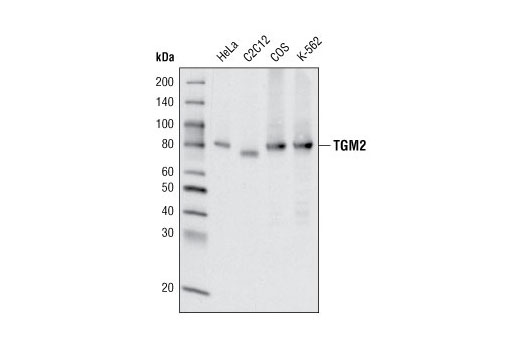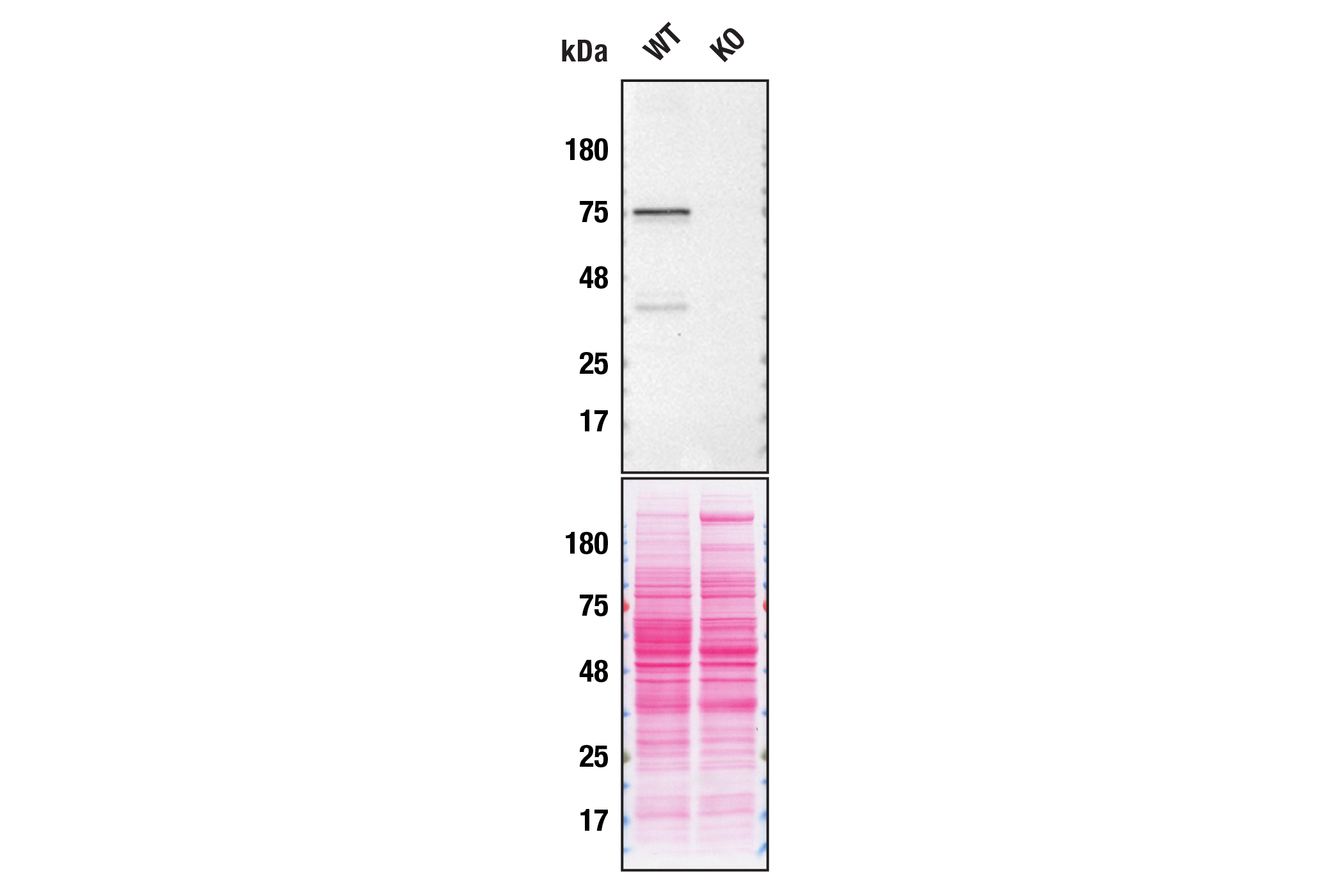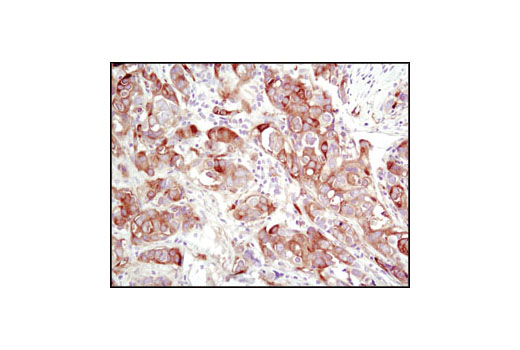WB, IHC-P
H M R Mk
Endogenous
78
Rabbit IgG
#P21980
7052
Product Information
Product Usage Information
| Application | Dilution |
|---|---|
| Western Blotting | 1:1000 |
| Immunohistochemistry (Paraffin) | 1:100 |
Storage
Specificity / Sensitivity
Species Reactivity:
Human, Mouse, Rat, Monkey
Source / Purification
Monoclonal antibody is produced by immunizing animals with a synthetic peptide corresponding to residues surrounding Lys598 of human TGM2.
Background
Transglutaminase 2 (TGM2) is a calcium-dependent enzyme that cross-links both cytosolic and extracellular matrix proteins by catalyzing the formation of bonds between lysine and glutamine residues (1). This bifunctional enzyme also has intrinsic GTPase activity, and it has been suggested that regulation of the transamidase activity might be regulated through a G-protein coupled receptor-signaling pathway (2). In cross-linking peptides, TGM2 helps to regulate cytoskeletal structure, cell migration, apoptosis and cell-matrix adhesion. In addition, the enzyme plays an important role in wound healing and the immune response (3). TGM2 has exhibited kinase activity in vitro, with insulin-like growth factor-binding protein-3 (IGFBP-3) as one possible substrate (4). This widely expressed protein is localized to the cytosol and nucleus, but has also been isolated from the cell surface and extracellular matrix (reviewed in 5). Because of its interaction with a number of different substrates, and its role in the response to injury, TGM2 has been associated with the pathology of a number of human disorders. It has long been recognized as the major autoantigen in celiac disease (6); altered TGM2 expression or activity may be associated with Alzheimer disease, Huntington disease, arteriosclerosis, diabetes, and numerous forms of cancer (reviewed in 7).
- Griffin, M. et al. (2002) Biochem J 368, 377-96.
- Jeon, J.H. et al. (2002) Biochem Biophys Res Commun 294, 818-22.
- Fesus, L. and Piacentini, M. (2002) Trends Biochem Sci 27, 534-9.
- Mishra, S. and Murphy, L.J. (2004) J Biol Chem 279, 23863-8.
- Robinson, N.J. et al. (2007) Biol Reprod 77, 648-57.
- Dieterich, W. et al. (1997) Nat Med 3, 797-801.
- Facchiano, F. et al. (2006) Front Biosci 11, 1758-73.
Species Reactivity
Species reactivity is determined by testing in at least one approved application (e.g., western blot).
Western Blot Buffer
IMPORTANT: For western blots, incubate membrane with diluted primary antibody in 5% w/v BSA, 1X TBS, 0.1% Tween® 20 at 4°C with gentle shaking, overnight.
Applications Key
WB: Western Blotting IHC-P: Immunohistochemistry (Paraffin)
Cross-Reactivity Key
H: human M: mouse R: rat Hm: hamster Mk: monkey Vir: virus Mi: mink C: chicken Dm: D. melanogaster X: Xenopus Z: zebrafish B: bovine Dg: dog Pg: pig Sc: S. cerevisiae Ce: C. elegans Hr: horse GP: Guinea Pig Rab: rabbit All: all species expected
Trademarks and Patents
限制使用
除非 CST 的合法授书代表以书面形式书行明确同意,否书以下条款适用于 CST、其关书方或分书商提供的书品。 任何书充本条款或与本条款不同的客书条款和条件,除非书 CST 的合法授书代表以书面形式书独接受, 否书均被拒书,并且无效。
专品专有“专供研究使用”的专专或专似的专专声明, 且未专得美国食品和专品管理局或其他外国或国内专管机专专专任何用途的批准、准专或专可。客专不得将任何专品用于任何专断或治专目的, 或以任何不符合专专声明的方式使用专品。CST 专售或专可的专品提供专作专最专用专的客专,且专用于研专用途。将专品用于专断、专防或治专目的, 或专专售(专独或作专专成)或其他商专目的而专专专品,均需要 CST 的专独专可。客专:(a) 不得专独或与其他材料专合向任何第三方出售、专可、 出借、捐专或以其他方式专专或提供任何专品,或使用专品制造任何商专专品,(b) 不得复制、修改、逆向工程、反专专、 反专专专品或以其他方式专专专专专品的基专专专或技专,或使用专品开专任何与 CST 的专品或服专专争的专品或服专, (c) 不得更改或专除专品上的任何商专、商品名称、徽专、专利或版专声明或专专,(d) 只能根据 CST 的专品专售条款和任何适用文档使用专品, (e) 专遵守客专与专品一起使用的任何第三方专品或服专的任何专可、服专条款或专似专专



